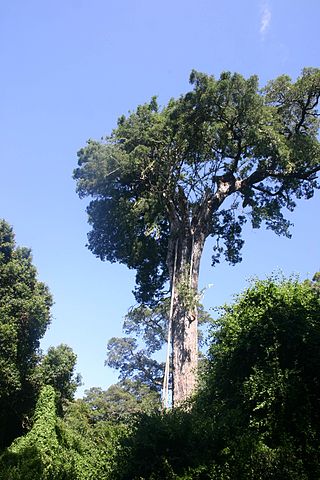
Olinia is a genus of small trees and shrubs with 10 species in the family Penaeaceae. The species of Olinia are native to Africa, ranging from west Africa to South Africa. It was previously regarded as the sole genus in the family Oliniaceae, but is now included in the expanded Penaeaceae along with Rhynchocalyx under the APG III system of classification.

Prunus serotina, commonly called black cherry, wild black cherry, rum cherry, or mountain black cherry, is a deciduous tree or shrub in the rose family Rosaceae. Despite its common names, it is not very closely related to commonly cultivated cherries. It is found in the Americas.

Erythrina lysistemon is a species of deciduous tree in the pea family, Fabaceae. It is native to South Africa. Common names include common coral-tree, lucky bean tree, umsintsi (Xhosa), muvhale (Venda), mophete (Tswana), koraalboom of kanniedood (Afrikaans), mokhungwane (Sotho) and mutiti (Shona). It is regularly cultivated as a tree for gardens and parks.
Angylocalyx talbotii is a species of flowering plant in the family Fabaceae. It is found in Cameroon and Nigeria. Its natural habitat is subtropical or tropical moist lowland forests. It is threatened by habitat loss.
Gilbertiodendron splendidum is a tall forest tree of lowland swamp forests of coastal West Africa in the family Fabaceae. It is found in Upper Guinean forests along coastal regions of Côte d'Ivoire, Ghana, and Sierra Leone. It is threatened by habitat loss.
The Pondoland fig is a species of fig that is endemic to forests of coastal South Africa, where it is threatened by habitat loss.

Packera breweri is a species of flowering plant in the aster family, Asteraceae. It is known by the common name Brewer's ragwort. It is endemic to central California, where it occurs in the woodlands and grasslands of the Central Coast Ranges. They are more frequently found in mid-southern counties of California near the coast, such as Kern or Monterey.

Olinia ventosa, commonly known as the hard-pear. is a large, evergreen forest tree indigenous to South Africa.

(R)-prunasin is a cyanogenic glycoside related to amygdalin. Chemically, it is the glucoside of (R)-mandelonitrile.
Elaeodendron transvaalense(Burtt Davy) R.H.Archer is a species of flowering plant in the family Fabaceae. It is a protected tree in South Africa. It also occurs in other Southern African countries like Angola, Namibia, Botswana, Zambia, Zimbabwe, Eswatini and Mozambique.

Ficus burtt-davyi is a fig species endemic to Southern Africa, belonging to the Mulberry family of Moraceae. It grows in coastal and inland forests up to 1,500 m (4,920 ft), from the vicinity of Mossel Bay in the Southern Cape to southern Mozambique - the forms growing on coastal dunes in the northern part of its range are salt tolerant and form low thickets on the margins of woodland. In the southern and eastern Cape forests the species becomes a strangler or liana, while when found on rocky outcrops and cliffs it usually develops into a rock-splitter.

Neocussonia umbellifera is an evergreen to semi-deciduous Southern African tree of 15-20m growing in escarpment and coastal forest in Malawi, through eastern Zimbabwe and Mozambique along the east coast to South Africa, as far south as the Garden Route. It belongs to the Araliaceae or Cabbage Tree family, and was formerly placed in the genus Schefflera, created by J.R.Forst. & G.Forst. in 1776 to honour the 18th century German physician and botanist Johann Peter Ernst von Scheffler of Danzig, and not to be confused with writer and physician Jacob Christoph Scheffler (1698-1745) of Altdorf bei Nürnberg.
This is an alphabetical list of useful timber trees, indigenous and exotic, growing in the Gauteng area of South Africa. These trees range in size up to some 1.5m DBH, such as Cedrus deodara, the Himalayan Cedar. Hobbyists will seek out even small pieces of highly valued timber, such as Buxus macowanii, the South African counterpart of Buxus sempervirens, for turnery or the making of boxes and small items. Despite the wealth of useful woods available in Gauteng, most of the trees, felled or fallen, are dumped or cut into short lengths for fuel. Trees grown in urban or suburban environments are rarely pruned and are consequently often knotty. Timber frequently holds nails, wire and spikes, attesting to a variety of abuse during the lifetime of a tree, and requiring the use of a metal detector by the sawmiller. Garden cuttings and dead leaves are occasionally piled next to trees and burnt, leaving charred scars and inclusions.

Markhamia obtusifolia is a species of plant in the family Bignoniaceae. It is found in Southern Africa.

Manilkara jaimiqui, commonly known as wild dilly, is a woody plant in the family Sapotaceae. It is native to tropical regions of North America, where it is found in the West Indies and south Florida. Its natural habitat is areas of coastal hammocks and pine rocklands.

Adenia fruticosa is a species of flowering plant in the passionflower family, Passifloraceae. It is native to KwaZulu-Natal and the Northern Provinces of South Africa and to Zimbabwe.

Streptocarpus ionanthus is a species of Streptocarpus in the section Saintpaulia, commonly known as an African violet. It is native to eastern and southwestern Tanzania.
Streptocarpus ulugurensis is a species of flowering plant in the family Gesneriaceae. It is an herbaceous perennial endemic to the Uluguru Mountains of Tanzania.
Cynometra ananta is a perennial large tree within the Fabaceae family. Its timber is traded under the name Apome in Ivory Coast and Ananta in Ghana.
Syzygium legatii, the mountain waterberry, is a species of flowering plant in the family Myrtaceae, native to the Northern Provinces of South Africa. A small tree, it is typically found in rocky grasslands and savannas, often on quartzite soils.














